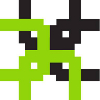1. To select a root note and scale, which will serve as a reference point for importing (if C5 is a root note, G4 would go to 2nd note of -1octave, and A4 to 2nd note of -1octave +2 semitones);
2. Split imported data to patterns of track 1…8 (split by 1/2 bar, 1 bar, 2 bar and so on);
3. Add a menu option "Copy selection to another pattern", which will do exactly that
This software is AWESOME, and the capability to easily import any existing melody lead bass into it would result in tremendous increase of popularity.

















